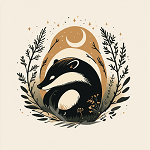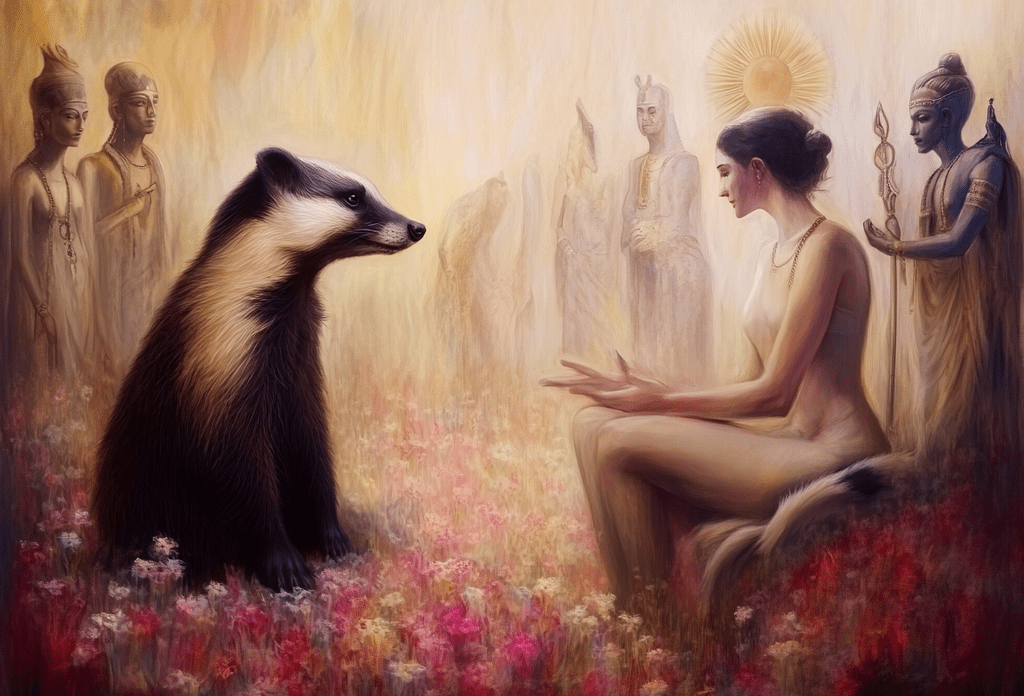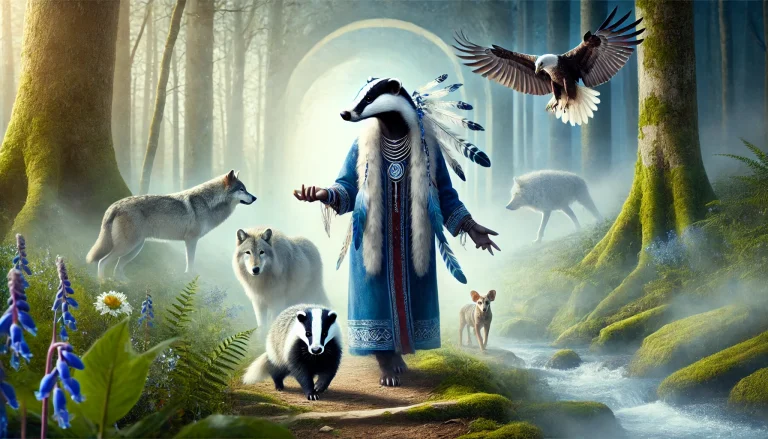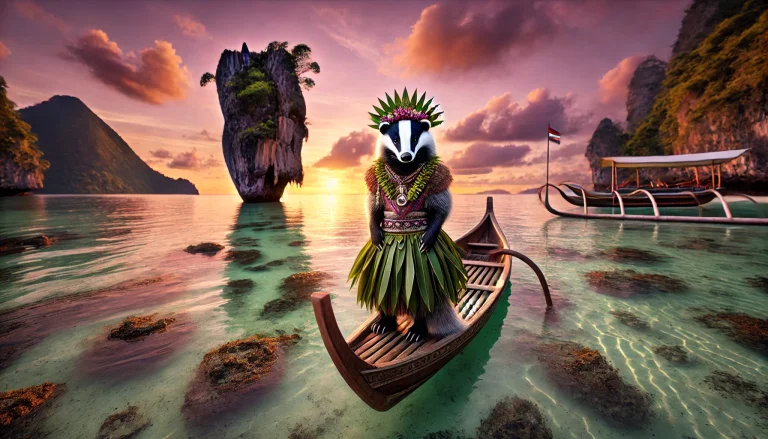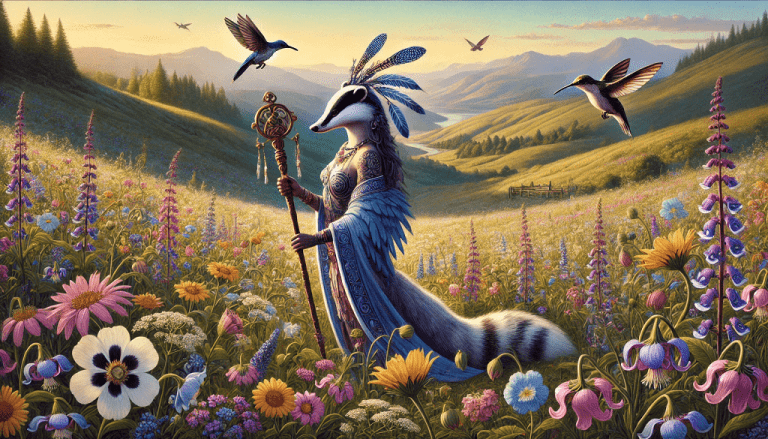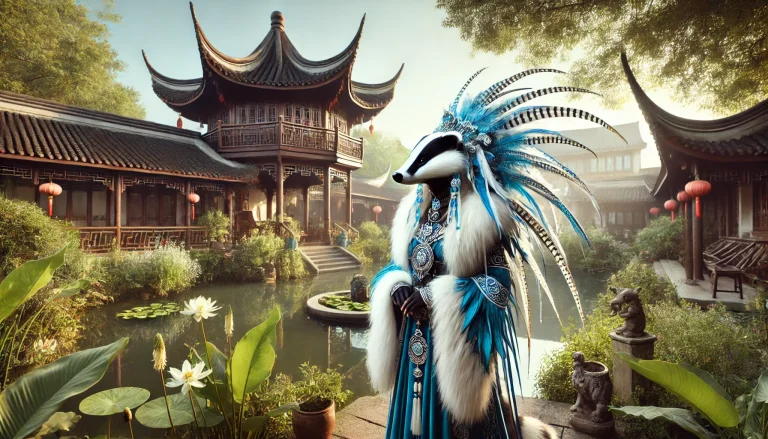Mythologies, with their stories of gods, heroes and fantastic creatures, have been fundamental in shaping cultures throughout human history. Much more than simple narratives, they reflect the beliefs, values and fears of different peoples, offering explanations about the origin of the universe, natural phenomena and human relationships. In the modern world, mythologies continue to influence not only cultural and religious traditions, but also science, art, literature, cinema and even video games. This article explores the lasting impact of mythologies on the contemporary world, revealing how these ancient stories remain alive and relevant today.
Index
What is myth?
The concept of "myth" is explored in various disciplines, such as philosophy, cultural studies and literature. From an early age, we hear about myths in artistic culture, social studies, history and literature classes.
A myth is an ancient folk tale that recounts the adventures of legendary heroes, gods and the origin of natural phenomena. Translated from Greek, the word "myth" (mythos) means "legend", and its use dates back to antiquity.
In a broader sense, myth, as an integral part of mythology, is a special way of relating to the world. It serves to generalize and unify the functions of religion, art and science in their most primitive forms. Our distant ancestors lived under what can be called mythological thinking, in which human history was seen as a succession of generations of gods, heroes and people, where animate natural elements played significant roles in the fate of mortals.
Many peoples created myths to try to understand how the universe worked, their place in it and how to live in harmony with the world around them. These stories helped them interpret the events around them, find their way in the universe, establish a social order and define their values. For ancient societies, myth was not just a fiction or fantasy; it was perceived as an integral part of everyday reality.
As well as explaining the unknown, myths also carried moral lessons, establishing norms of behavior and passing on accumulated wisdom from generation to generation. Each culture has developed its own mythology, creating a rich mosaic of narratives that reflect the beliefs, fears and hopes of different peoples.
In Greek mythology, for example, the Olympian gods not only ruled the world, but also displayed human characteristics, with virtues and flaws. Nordic mythology, on the other hand, is full of stories of courage and tragedy, reflecting the hostile environment in which its peoples lived. Egyptian mythology, on the other hand, revolves around the afterlife and cosmic order, central themes for a civilization that built lasting monuments such as the pyramids.
Even today, myths continue to influence our culture, appearing in films, books and even in everyday life, when we use expressions like "Pandora's box" or "Hercules' work". They are therefore much more than just stories; they are powerful symbols that continue to shape our understanding of the world and of ourselves.
What is mythology
Mythology is a complete system of myths, a set of ancient ideas about the world and life. Mythological thinking is considered the first form of human consciousness, used to explain the action of unknown forces of nature, identify patterns between events, satisfy curiosity and provide a sense of protection. This type of thinking is characterized by a fantastic nature, a specific organization of time and space, and a division of the world into opposites, such as light and darkness, life and death, chaos and order.
In many mythologies around the world, we find similar plots and images. Scientists and scholars believe that this convergence can be explained by several factors:
- Common ancestor: Many genetically related peoples may have inherited stories and myths from a common ancestor.
- Cultural interaction: Stories spread from one tradition to another through contact between different cultures.
- Life circumstances: The natural environment, such as climate and terrain, influenced similar myths in different regions.
- Resettlement of tribesWhen tribes migrated to new territories, they took their myths with them and adapted them to the new context.
Some common motifs in various mythologies include the creation of the world from the body of a primordial being, the origin of humanity from clay or earth, the gigantic size of mythical creatures, and the idea of a world axis that connects the space of gods, humans and the afterlife.
The best-known examples of mythical characters come from Greek and Roman mythologies, where the gods not only ruled aspects of life and nature, but also displayed supernatural abilities and complex personalities, full of virtues and flaws. These gods and heroes are archetypal representations that continue to influence Western culture to this day.
Mythology not only reflected human understanding of the world, but also played a crucial role in social cohesion and the transmission of cultural values. In many ways, it was the basis for the religions and traditions that shaped entire civilizations.
Mythologies around the world
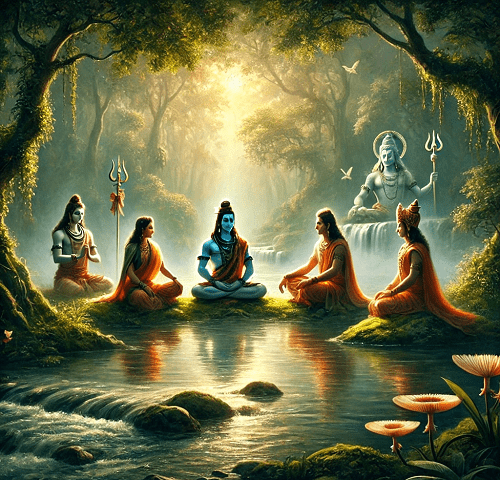
Hindu mythology
Hindu mythology is one of the oldest and richest in the world, with a vast and complex collection of gods, demons, heroes and epics. At the heart of these beliefs is the concept of an infinite cycle of creation, preservation and destruction of the universe.
Creation of the Universe:
According to Hindu mythology, the universe goes through eternal cycles of creation, preservation and destruction. In the beginning, everything was a vast, endless ocean of chaos. Brahmathe creator god, emerged from a lotus that was born from the navel of Vishnuwhich floated in the cosmic waters. Brahma then created the universe, including the gods, demons, human beings and the material world. The universe is maintained by Vishnu, the preserver, and will be destroyed by Shivathe god of destruction, so that the cycle can begin again.
The Three Main Gods:
- Brahma: The creator god, responsible for shaping the universe and everything in it. He is often depicted with four heads, representing the four Vedas, which are India's oldest sacred texts.
- Vishnu: The preserver of the universe, who takes on various incarnations (or avatars) to restore the dharma (the cosmic order). Among his most famous avatars are Ramathe hero of the epic Ramayana, e Krishna, one of the central figures of the Mahabharata.
- Shiva: The god of destruction and regeneration. Shiva is often represented as the master of the cosmic dance, the Natarajawhich symbolizes the cycle of creation and destruction. He is worshipped both as the destroyer of worlds and as the benevolent one who brings renewal and transformation.
Other Important Deities:
- Lakshmi: The goddess of wealth, prosperity and beauty, and consort of Vishnu. She is worshipped by those who seek fortune and success.
- Saraswati: The goddess of knowledge, music, art and wisdom. She is Brahma's consort and is often depicted playing a veena, a musical instrument.
- Durga: A warrior goddess who fights evil, often depicted riding a lion or tiger and holding various weapons in her many arms. She is a form of Shiva's consort, Parvati.
- Ganesha: The elephant-headed god, son of Shiva and Parvati, is revered as the remover of obstacles and the god of wisdom and beginnings.
The Epics and the Scriptures:
Hindu mythology is largely narrated in two fundamental epics:
- Ramayana: Tell the story of the prince Rama, his wife Sitaand his battle against the devil Ravana.
- Mahabharata: One of the world's greatest epics, it chronicles the war between the Pandavas and the Kauravas, including Krishna's famous speech to Arjuna, known as the Bhagavad Gita.
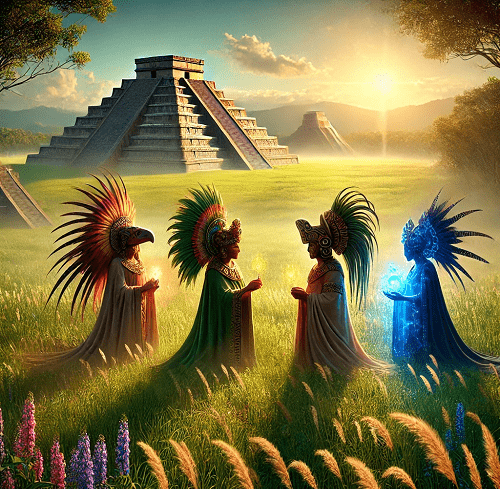
Mesoamerican Mythology
Mesoamerican mythology includes the beliefs and myths of the ancient civilizations that flourished in the region now known as Mesoamerica, covering parts of Mexico, Guatemala, Belize, Honduras and El Salvador. Among the most prominent civilizations were the Aztecs, Mayans and Olmecs. These cultures shared mythological themes and figures, although each had its own interpretations and specific gods.
Creation of the World:
In Mesoamerican mythology, the creation of the world is often seen as a cyclical process, with the universe being created and destroyed repeatedly. In Aztec myth, for example, the universe went through several eras called the SunsEach ended in catastrophe. The current era is known as the Fifth Sun.
According to Aztec mythology, the gods gathered in Teotihuacan to decide who would be the next Sun. Two gods, Tecciztecatl e NanahuatzinThey offered themselves for sacrifice. Nanahuatzin, being humble, accepted and threw himself into the fire, becoming the Sun. Tecciztecatl, full of pride, hesitated, but ended up throwing himself in too, becoming the moon. In order for the Sun to move and illuminate the world, the gods sacrificed their lives, establishing the practice of human sacrifice as central to Aztec religion.
Important Gods:
- Quetzalcoatl: The feathered serpent god, one of the most revered deities in all of Mesoamerica. He was the god of wind, wisdom and life, and was also considered the creator of humanity. According to the myths, Quetzalcoatl created humans from the bones of ancient giants mixed with his own blood.
- Huitzilopochtli: The god of war and the sun, who was the patron saint of the Aztec city of Tenochtitlan. He was one of the main gods of the Aztec pantheon and was often associated with human sacrifice. Huitzilopochtli guided the Aztecs to their promised land, where they founded Tenochtitlan.
- Tezcatlipoca: The god of the night, fate and war. He was one of the most powerful gods and was often in conflict with Quetzalcoatl. Tezcatlipoca was associated with death, destruction and chaos, but also with regeneration and rebirth.
- Tlaloc: The god of rain and fertility, responsible for storms and the supply of water, essential for crops. He was feared and revered because he could bring both beneficial rains and destructive storms.
- Chac: In Mayan mythology, Chac is the god of rain and storm, similar to Tlaloc among the Aztecs. He was worshipped as the provider of water for the crops, and his symbol, the lightning bolt, was seen as a means of fertilizing the earth.
The Popol Vuh:
Among the Maya, the Popol Vuh is a sacred text that recounts the creation of the world, the origin of humanity and the adventures of the twin heroes Hunahpú e Ixbalanqué. According to the Popol Vuh, the gods created humans several times, first out of clay, then wood, until finally they made them out of corn, which is considered sacred in Mayan culture. Twin heroes also play a crucial role in Mayan mythology, defeating the lords of the underworld and establishing order in the world.
The Underworld:
In Mesoamerican mythology, the underworld is a recurring theme. For the Maya, it was known as XibalbaIt was a place ruled by gods of the underworld who imposed challenges and tests on the dead. In Aztec culture, the underworld was called the Mictlan, governed by Mictlantecuhtlithe god of death. The underworld was a difficult place to cross, where the dead had to overcome various obstacles to reach their final resting place.
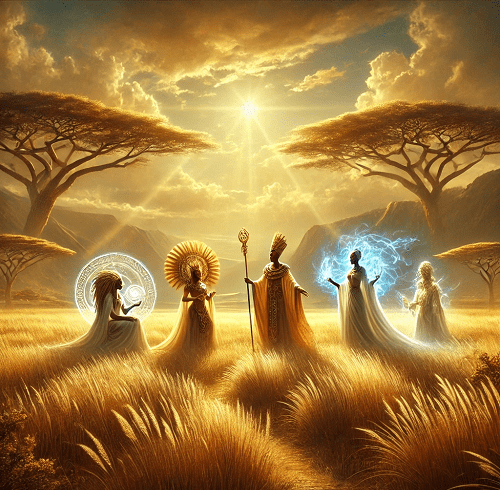
African Mythology
African mythology is vast and diverse, reflecting the continent's rich cultural tapestry of hundreds of ethnic and tribal groups, each with their own stories and deities. African mythologies often explain the origin of the world, natural phenomena and the relationships between human beings, gods and spirits. Some of the most influential mythologies include the traditions of the Yoruba and peoples Bantosand other cultures from West and Central Africa.
Creation of the World:
In many African traditions, the creation of the world is attributed to a supreme deity. Among the Yoruba, for example, the creator god is Olodumarealso known as Olorun. He is the source of all life and the supreme god of the Yoruba pantheon. Olorun delegated the creation of the Earth to the god Obataláwho molded the first human beings out of clay. In some versions, Obatalá is assisted by Orunmilathe god of wisdom and divination, to ensure that creation was successful.
In the mythology of peoples Bantosthe creator god Nzambi Mpungu also plays a central role. He is seen as the creator of the universe and of the natural laws that govern life. In several narratives, Nzambi Mpungu creates the world and then retires to the heavens, leaving humans with the ancestral spirits to guide their lives.
Important Gods and Spirits:
- Olodumare/Olorun: The supreme god in Yoruba mythology, who is considered omniscient, omnipresent and omnipotent. He is not worshipped directly by humans, but through the Orishaswhich are minor manifestations of his power.
- Obatalá: The god of purity and creator of humanity in the Yoruba tradition. He is revered as the god of peace, justice and compassion, and is often associated with white and the upper echelons of spirituality.
- Orunmila: The god of wisdom, knowledge and divination. He is Olorun's main advisor and is known for his role in the Ifá divination system, which is central to Yoruba religious practice.
- Shango: The god of thunder, war and justice. Shango is one of the most popular deities among the Yoruba and is associated with power and virility. He is often invoked in matters of justice and for protection against enemies.
- Oshun: The goddess of love, fertility and rivers. She is one of the most important Orishas and is revered as a compassionate and generous deity, who protects women and promotes harmony in relationships.
- Nzambi Mpungu: In the mythology of the Bantu peoples, he is the supreme god and creator, responsible for the creation of the world and all living beings. He is a distant figure who, after creation, leaves humanity to go his own way, but continues to be respected as the supreme ruler of the universe.
Ancestors and Spirits:
In African mythology, ancestral spirits play a central role. Ancestors are often seen as intermediaries between the gods and the living, protecting their families and communities. They are honored through rituals and offerings, and are believed to have an influence on the health, prosperity and well-being of the living.
Nature spirits are also fundamental in African traditions. Many African cultures believe that trees, rivers, mountains and other natural elements are inhabited by spirits who must be respected and appeased to ensure harmony with the environment.
Myths and Narratives:
- Anansi: One of the most famous characters in African mythology, especially in the cultures of Ghana and Ivory Coast. Anansi is a trickster who often defies the gods and deceives other beings to get what he wants. He is an ambiguous figure, both hero and villain, and his stories teach lessons about intelligence, cunning and morality.
- Mawu-Lisa: In the mythology of the Fon peoples of Benin, Mawu and Lisa are twin gods who together represent the duality of the universe. Mawu is the goddess of the moon and night, while Lisa is the god of the sun and day. Together, they rule the universe and maintain the balance between the opposing forces.
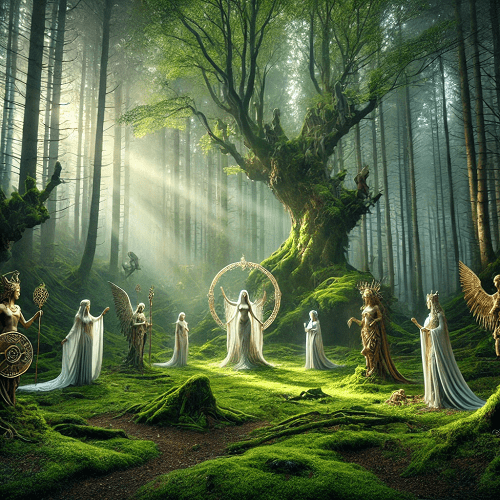
Celtic mythology
Celtic mythology originates from Irish, Welsh, Scottish and Breton cultures, and is rich in heroic figures, gods and magical creatures. This mythology is known for its strong connection with nature, the cycle of the seasons, and the concepts of honor and courage. Most Celtic stories were passed down orally by druids, and much of what is known today comes from medieval manuscripts that recorded these traditions.
Creation of the World:
Celtic mythology does not have a universally recognized creation myth, as in other cultures. Instead, Celtic stories focus on cycles of invasions and the arrival of different groups of gods and supernatural beings in Ireland. The most famous of these cycles is the Mythological Cyclewhich includes the arrival of the Tuatha Dé Dananna group of gods and magical beings who ruled Ireland before the arrival of humans.
Gods and Important Beings:
- Dagda: Known as the "Good God", Dagda is one of the most important deities in Celtic mythology. He is a god of fertility, weather and magic, and is often described as a giant of great strength and appetite, carrying a huge club that can kill with one blow or bring life back with a touch.
- Brigid: Goddess of healing, poetry and the forge, Brigid is one of the most revered deities in Celtic tradition. She is associated with fire and light, and their festival, ImbolcBrigid's birthday, marks the beginning of spring. Brigid is a central figure in both Celtic mythology and Irish Christianity, where she has been syncretized as Saint Brigid.
- Lugh: The god of skill, war and the arts, Lugh is a multi-purpose deity who is often portrayed as a skilled young warrior. He is associated with the festival of Lughnasadhwhich celebrates the harvest. Lugh is known for his role in the Ulster Cyclewhere he led the Tuatha Dé Danann against the Fomorians, an old enemy.
- Morrigan: Goddess of war and fate, Morrigan is a dark figure associated with death and destruction. She is often described as a triad of goddesses (Badb, Macha and Nemain) and is known to appear in the form of a raven over battlefields, prophesying the death of warriors.
- Cernunnos: The god of animals, abundance and fertility, Cernunnos is often depicted with deer antlers and surrounded by wild creatures. He is a deity associated with wild nature and rural life, symbolizing the eternal cycle of life, death and rebirth.
Heroes and Legends:
- Chulainn ass: One of the most famous heroes of Celtic mythology, Cú Chulainn is the protagonist of Ulster Cycle. He is an extraordinary warrior who, at a young age, defended the kingdom of Ulster against Queen Medb's army in the famous Táin Bó Cúailnge (The Abduction of the Cooley Bulls). Known for his battle rage (ríastrad), he transforms into an almost supernatural figure during the fight.
- Fionn mac Cumhaill: Leader of the Fianna, a group of hunting warriors, Fionn is the central hero of the Fenian Cycle. He is known for his wisdom and courage, as well as for adventures that include the search for the Salmon of WisdomA mythical fish that grants absolute knowledge to those who consume it.
- The Sidhe (or Sí): In Celtic mythology, the Sidhe are a race of supernatural beings who live on hills or mountains. They are often associated with the Tuatha Dé Danann and are seen as the inhabitants of the Otherworld, a mystical realm separate from the world of mortals. The Sidhe are powerful beings, capable of great feats of magic, but they can also be dangerous if disrespected.
The Other World:
O Another World is a central concept in Celtic mythology. It is a magical realm where gods and spirits dwell, and where time passes differently. Mortals can access the Otherworld through natural portals, such as hills, lakes and caves, especially at liminal times of the year, such as Samhain (fall) and Beltane (spring).
Festivals and Rituals:
The Celts celebrated many festivals linked to seasonal cycles, including:
- Samhain: Marking the end of the harvest and the beginning of winter, Samhain is one of the most important festivals, associated with contact with the dead and the opening of the portal to the Other World.
- Beltane: It celebrates the arrival of summer and is a fertility festival, with bonfires and rituals to protect crops and livestock.
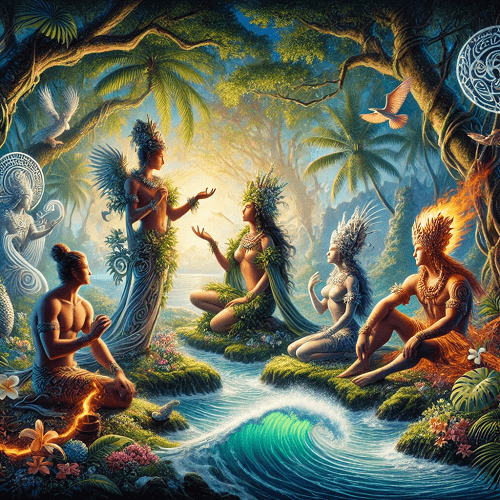
Polynesian mythology
Polynesian mythology encompasses the beliefs and traditions of the peoples who inhabit the Pacific islands, including Hawaii, Tahiti, Samoa, Tonga, and New Zealand (Maori). This mythology is rich in stories about the creation of the world, cultural heroes and gods who govern the natural elements. Polynesian spirituality is deeply connected to the ocean, the sky and the islands, reflecting the insular environment in which these cultures developed.
Creation of the World:
In Polynesian mythology, the creation of the world is generally described as a process that began from a void or primordial darkness, known as the Te Kore (nothingness) or Po (darkness), depending on the specific tradition.
One of the best-known creation myths is that of the god Tāne (or Tāne Mahutain the Maori tradition), who separated his parents, Rangi (the sky) and Pope (the earth), who were bound in a tight embrace, trapping the world in darkness. By separating Rangi and Papa, Tāne brought light to the world, creating the space between heaven and earth where humans could live. From her tears of sorrow at the separation, rivers and seas were born.
Important Gods:
- Tāne: The god of the forest and birds, and one of the main gods of Polynesian mythology, especially among the Maori of New Zealand. He is the creator of humanity and responsible for all living beings that inhabit the earth. Tāne is seen as a vital force that connects heaven and earth.
- Tangaroa: The god of the sea and one of the supreme gods of Polynesian mythology. Tangaroa is worshipped on many Pacific islands as the progenitor of all marine life, and is associated with the ocean, fishing and navigators. He is seen as a powerful deity who needs to be respected to ensure safety when traveling by sea.
- Māui: One of the most famous cultural heroes of Polynesian mythology, present in many Pacific island traditions. Māui is known as a trickster and is credited with many feats, such as fishing the islands of Hawaii with a magic hook, slowing down the movement of the sun to lengthen the day, and bringing fire to mankind. His adventures show both his mischievous character and his importance as a benefactor to mankind.
- Rongo: The god of agriculture, peace and fertility, especially associated with yam cultivation and the harvest. Rongo is an important deity for Polynesian agrarian communities, guaranteeing abundance and sustenance.
- Skin: The goddess of volcanoes and fire, revered especially in Hawaii. Pele is a powerful deity, known as much for her creativity as for her destructiveness. She resides in the Kīlauea volcano, and is responsible for creating the Hawaiian islands through her eruptions. Hawaiians make offerings to Pele to appease her and protect their lands from volcanic fury.
- Hina: An important goddess in Polynesian mythology, often associated with the moon, weaving and fertility. Hina appears in many different stories, including the famous legend of Hina and the demon whom she defeated using her weaving skills.
Heroes and Legends:
- Hina and Māui: In some versions of mythology, Hina is Māui's sister or wife, and together they play key roles in many stories. Hina is often portrayed as a wise and magical figure, complementing Māui's mischievous character.
- Rangi and Papa: The story of Rangi (the sky) and Papa (the earth) is one of the most important in Maori mythology, representing the love and separation that gave birth to the world. Their many children, who are gods of various aspects of nature, tried to separate their parents to create space and light, with Tāne succeeding in this task.
- Aumakua: The aumakua are ancestral spirits who act as family guardians in many Polynesian traditions, especially in Hawaii. They can take the form of animals such as sharks, owls or lizards, and are revered as protectors who guide and assist their living families.
The Spirit World:
Polynesian mythology is also rich in stories about the Another Worldor the realm of the spirits, where the souls of the dead reside. This spiritual world is often accessible through caves, mountains or the ocean, and is considered both a place of rest and a continuation of life after death.
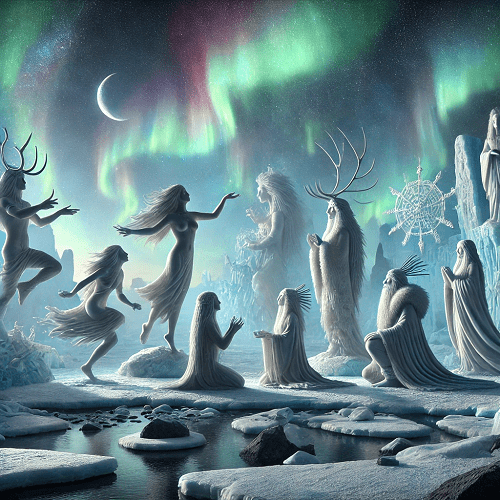
Inuit mythology
Inuit mythology reflects the beliefs and spiritual traditions of the Inuit peoples, who inhabit the Arctic regions of Canada, Alaska, Greenland and parts of Siberia. This mythology is deeply rooted in the Inuit's relationship with the hostile Arctic environment, where respect for nature and the spirits that inhabit it is central to survival. Inuit stories and legends are passed down orally and emphasize harmony with the natural world and spiritual forces.
Creation of the World:
Inuit mythology does not have a universal creation myth, but many stories explain the origin of natural elements and the relationships between humans, animals and spirits. A common theme is the transformation of humans into animals and vice versa, reflecting the belief in the interconnectedness of all life forms.
One of the best-known creation myths involves SednaSedna is the goddess of the sea and marine animals. According to legend, Sedna was a young woman who was thrown into the ocean by her father after a conflict. When she fell into the icy waters, Sedna was transformed into a powerful goddess. Her severed fingers turned into seals, whales and other marine animals. Sedna came to rule the seabed, and the Inuit hunters had to appease her to ensure their hunting success.
Important Gods and Spirits:
- Sedna: The goddess of the sea, mother of all marine beings and one of the most important deities in Inuit mythology. Sedna controls the abundance of marine animals, and Inuit shamans often appease her spirit to ensure good hunting and to avoid disasters at sea.
- Anguta: In Inuit mythology, Anguta is Sedna's father and is associated with the underworld. He is responsible for guiding the souls of the dead to the spirit realm, where they find peace. Anguta is an ambiguous figure, both feared and respected by the Inuit.
- Nanook: The god of polar bears, who is considered the protector of these majestic animals. The Inuit believed that Nanook ruled over all polar bears and decided whether or not Inuit hunters would succeed in their hunts. It was essential to treat the polar bear with great respect to ensure that Nanook continued to bless the community with game.
- Tornarssuk: A powerful spirit associated with the weather, especially storms and wind. Tornarssuk can be benevolent or malevolent, depending on the behavior of humans. He is often invoked by shamans to calm storms or bring good weather.
- Sila: The spirit of the air and the weather, Sila is an invisible force that controls the wind, the weather and atmospheric conditions. Sila also represents the concept of soul or spirit in many Inuit contexts, being an omnipresent presence that influences all aspects of life.
Heroes and Legends:
- Kiviuq: One of the most famous legendary heroes in Inuit mythology, Kiviuq is an adventurer who travels long distances, facing supernatural challenges, monsters and spirits. His stories vary from region to region, but he is always portrayed as a resourceful survivor who uses cunning and courage to overcome obstacles.
- Qallupilluk: Mysterious beings that inhabit the icy waters of the Arctic, Qallupilluk are described as creatures that capture disobedient children who get too close to the ice. This legend serves as a cautionary tale, teaching Inuit children to respect the dangerous nature of the Arctic.
The Spirit World:
Inuit mythology is deeply connected to the spirit world, where the spirits of ancestors and nature play central roles. The shamans, known as angakoksThey are the intermediaries between humans and the spirit world. They perform rituals and spiritual journeys to cure illnesses, predict the future and appease spirits like Sedna, ensuring the survival of the community.
The Inuit spirit world is seen as a reflection of the physical world, where each element of nature, such as animals, mountains and rivers, has a spirit. These spirits need to be respected and treated with reverence in order to maintain harmony between humans and the natural environment.

Greek Mythology
Greek mythology is one of the most influential and widely studied in the Western world. It encompasses a vast collection of stories about gods, heroes and mythical creatures that were central to the culture and religion of Ancient Greece. These stories were passed down orally and later recorded in literary texts that continue to influence art, literature and philosophy to this day.
Creation of the World:
According to Greek mythology, in the beginning there was only the ChaosA primordial mixture without form. From Chaos emerged Gaia (the Earth), Eros (Love), Tartarus (the Abyss) and Erebos (the Dark). Gaia, without the help of any partner, gave birth to Uranus (the Sky), who became her consort. Together, Gaia and Uranus generated the Titansa powerful race of gods.
Uranus, fearing the power of his sons, imprisoned them in Tartarus, which led Gaia to plot against him. Her youngest son, CronosHe led the revolt, castrating Uranus and taking his place as ruler of the universe. From the blood of Uranus, fallen to earth, came the Erinyes (Furies), the Giants and the Melias (tree nymphs).
Important Gods and Deities:
- Zeus: The youngest of Kronos' sons, Zeus escaped the fate of being devoured by his father and eventually led the revolt of the gods against the Titans in the Titanomachy. After his victory, Zeus became king of the gods and ruler of Mount Olympus. He is the god of the sky and thunder and is associated with justice and order.
- Ivy: Wife of Zeus and queen of the gods, Hera is the goddess of marriage and fertility. She is known for her jealous temper and for protecting the sanctity of marriage by punishing Zeus' lovers and illegitimate children.
- Poseidon: Brother of Zeus, Poseidon is the god of the sea, earthquakes and horses. He is a powerful and temperamental deity who rules over all the waters of the world.
- Hades: Another brother of Zeus, Hades is the god of the underworld and the dead. He rules the realm of the dead, known as Hades or Erebusand is associated with underground wealth, such as precious metals and stones.
- Athena: Daughter of Zeus, Athena is the goddess of wisdom, strategic warfare and justice. Born fully formed and armed from the head of Zeus, Athena is one of the most revered deities and protectors of cities, especially Athens.
- Aphrodite: The goddess of love, beauty and desire, Aphrodite was born from the sea when the remains of Uranus fell into the water. She is one of the most enchanting figures in Greek mythology and is often involved in stories of love and intrigue.
- Apollo: Son of Zeus and Leto, Apollo is the god of the sun, music, poetry, prophecy and healing. He is the twin brother of Artemis and is associated with light and truth.
- Artemis: The twin sister of Apollo, Artemis is the goddess of the hunt, wild nature and chastity. She is the protector of young people and animals, and is revered as the goddess of the moon.
- Hephaestus: The god of fire, forging and metallurgy, Hephaestus is the craftsman of the gods, creating their weapons and armor. He is the son of Hera (sometimes with, sometimes without Zeus) and is known for his skill, despite being lame.
- Air: The god of war and violence, Ares is the son of Zeus and Hera. He is a controversial figure, revered for his strength, but also feared for his destructive and bellicose nature.
Heroes and Legends:
- Hercules (Heracles): One of the most famous heroes of Greek mythology, Hercules is known for his extraordinary strength and for the twelve tasks he performed as penance, known as the Twelve Labors of Hercules. He is the son of Zeus and the mortal Alcmena.
- Theseus: The hero and king of Athens, Theseus is famous for killing the Minotaur in the labyrinth of Crete. He is a symbol of courage and cunning, often associated with the unification of Athens.
- Perseus: Another great hero, Perseus is known for killing the Medusathe gorgon who turned those who looked directly at her into stone. With the help of the gods, Perseus completed this feat and saved Andromeda, who became his wife.
- Achilles: The main hero of IliadIn Homer's Trojan War, Achilles is an almost invulnerable warrior, except for his heel. He is one of the central characters in the Trojan War and is known for his bravery and tragic mortality.
The World of the Dead:
In Greek mythology, the underworld is ruled by Hades and is the destination of souls after death. The underworld is divided into several regions, including the Elysian Fields (for the righteous and heroes), the Tartarus (for convicts), and the Asfódelos (for most ordinary souls). The entrance to the underworld is guarded by Cerberusthe three-headed dog.
Oracles and Prophecies:
The Greeks attached great importance to prophecies and oracles, the most famous being the Oracle of DelphiThe oracle was dedicated to Apollo. Oracles were consulted to guide important decisions, and their often enigmatic prophecies played crucial roles in legends and myths.

Nordic mythology
Norse mythology, which originated with the Germanic and Scandinavian peoples, is one of the richest and most complex of the ancient world. It is full of powerful gods, brave heroes and fantastic creatures, all living in a cyclical universe of creation and destruction. The Norse stories were passed down orally for centuries before being recorded in texts such as the Eddas in the medieval period.
Creation of the World:
In Norse mythology, the universe began with the Ginnungagapa vast emptiness. On one side of the Ginnungagap there was Niflheimthe land of ice, and on the other side, Muspelheimthe land of fire. When the sparks of Muspelheim met the ice of Niflheim, the first living being, the ice giant Ymirwas created. From the ice also came Audumlathe cosmic cow, who fed Ymir with her milk.
While Ymir slept, another giant was born from his feet, Trudgelmirand other ice giants. Meanwhile, Audumla licked the salty ice and released Burithe first of the gods. Buri begot Borwho had three children: Odin, Vili e Ve. These brothers killed Ymir and used his body to create the world. Ymir's blood formed the seas, his flesh became the earth, his bones the mountains, and his skull the sky.
Important Gods and Deities:
- Odin: The supreme god of the Norse pantheon, Odin is the god of wisdom, war and death. He is known for sacrificing one of his eyes in exchange for knowledge, and for hanging from the Yggdrasil tree to obtain the runes, mystical symbols of power. Odin is often associated with ravens Huginn e Muninn (Thought and Memory), which fly around the world and bring information back to him.
- Thor: Son of Odin, Thor is the god of thunder, lightning and strength. He is the protector of the gods and humanity against the giants. Thor wields the mighty hammer MjölnirHe is one of the most popular and revered gods in Norse mythology. He is one of the most popular and revered gods in Norse mythology.
- Loki: The god of fire and trickery, Loki is a complex and ambiguous figure. He is both a helper and a troublemaker for the gods. Although he is often responsible for bringing chaos, his actions often result in unexpected benefits for the gods. Loki is the father of several monstrous creatures, including the wolf Fenrirthe snake Jormungandr, e Helthe goddess of the underworld.
- Freyja: The goddess of love, beauty, fertility and war. Freyja is one of the main female deities and is associated with seidr magic, a form of divination. She rides a chariot pulled by cats and rules the battlefield Fólkvangrwhere half the warriors killed in battle go, with the other half going to Valhalla.
- Heimdall: The guardian of the bridge BifrostHeimdall is the first of his kind, connecting the world of the gods, Asgard, to the world of humans, Midgard. Heimdall has extraordinary senses, being able to hear grass grow and see great distances. He is the god who announces the beginning of Ragnarökthe end of the world, blowing its horn Gjallarhorn.
- Balder: The god of light, purity and beauty. Balder is loved by all the gods, but his fate is tragic. He is killed by a mistletoe arrow, manipulated by Loki, triggering a series of events that lead to Ragnarök.
Ragnarök:
O Ragnarök is the Norse apocalypse, a prophesied event in which the gods, giants and monsters will fight a final battle that will result in the destruction of almost all living beings. During Ragnarök, many of the main gods, including Odin, Thor and Loki, will meet their deaths. The world will be consumed by fire, but will eventually be reborn from the ashes, with new gods and human survivors to repopulate it.
The Underworld and Other Worlds:
Norse mythology describes nine worlds connected by the cosmic tree Yggdrasil:
- Asgard: The kingdom of the Aesir, the main gods.
- Midgard: The world of humans.
- Vanaheim: The kingdom of the Vanir, another tribe of gods associated with fertility and nature.
- Jotunheim: The kingdom of giants.
- Alfheim: The kingdom of the light elves.
- Svartalfheim: The kingdom of the dark elves or dwarves, known for their forging skills.
- Niflheim: The world of ice and mist.
- Muspelheim: The world of fire.
- Helheim: The realm of the dead, ruled by Hel, daughter of Loki.
Heroes and Legends:
- Sigurd: One of the most famous heroes in Norse mythology, Sigurd is known for slaying the dragon Fafnir and his tragic love affair with the Valkyrie Brynhild. Their stories are told in Poetic Edda and the Nordic sagas.
- Beowulf: Although his story is told in an Anglo-Saxon poem, Beowulf is often associated with Norse mythology. He is a hero who faces monsters such as Grendel and a dragon, representing the ideal of the Nordic warrior.
Ritual and Practice:
Nordic religious practice involved sacrifices (blóts), offerings and seasonal festivals, often held in large halls or outdoors. Runes were used for divination and magic, and temples were dedicated to the main gods, especially Odin and Thor.
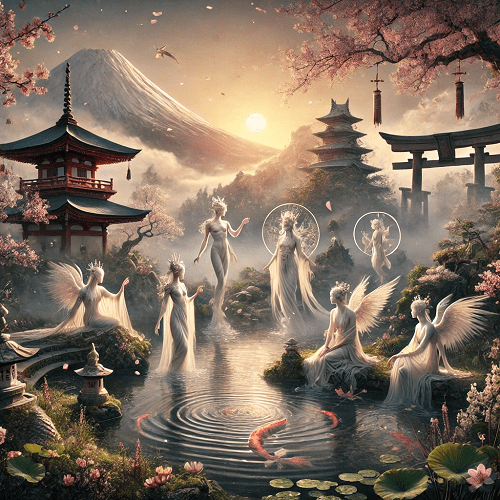
Japanese mythology
Japanese mythology is a rich set of stories that combine Shinto, Buddhist and folk traditions. It explains the origin of Japan, its gods (kami), and its beliefs about nature and the afterlife. Mythology is mainly recorded in ancient texts such as the Kojiki (Records of Ancient Matters) and the Nihon Shoki (Chronicles of Japan).
Creation of the World:
According to Japanese mythology, in the beginning there was chaos. From this chaos, particles emerged and organized themselves, forming the TakamagaharaThe High Celestial Plain, where the first gods (kami) began to appear. Among these gods, the most important are the Kotoamatsukamiwhich include figures such as Ame-no-Minakanushi. These first gods gave rise to the Kamiyonanayoa group of twelve deities.
The creation of the Earth begins with the gods Izanagi e Izanamithe last of the Kamiyonanayo, who were given the mission of forming the earth. With the celestial spear Ame-no-NubokoThey stirred up the primordial ocean, and when they lifted the spear, drops fell, forming the first island, Onogoro-shima. Izanagi and Izanami then descended to earth and created the other islands that make up the Japanese archipelago, as well as various other gods.
Important Gods and Deities:
- Izanagi and Izanami: They are the creator gods, responsible for forming the islands of Japan and giving birth to many other gods. Izanami died giving birth to the god of fire KagutsuchiThis led Izanagi to descend into Yomi, the realm of the dead, to try and rescue her, but without success. This journey resulted in the separation between the world of the living and the dead.
- Amaterasu: The goddess of the sun and one of the most revered deities in Japanese mythology. She is the daughter of Izanagi and is considered the divine ancestor of the Japanese imperial family. Amaterasu is the goddess who brought light to the world and is central to Shinto worship. Her importance is symbolized by the fact that the sun, represented by her, is a central element in Japan's flag.
- Tsukuyomi: The moon god, brother of Amaterasu, also born from the eyes of Izanagi. Tsukuyomi is a less prominent figure and, according to some legends, was separated from his sister after a conflict.
- Susanoo: The god of the sea and storms, also the brother of Amaterasu and Tsukuyomi. Susanoo is known for his impulsive temper and has often caused trouble for the other gods. He was banished from heaven after a series of incidents, but redeemed himself by killing the eight-headed serpent Yamata-no-Orochi and rescue the princess Kushinada-hime.
- Kagutsuchi: The god of fire, whose birth caused the death of Izanami. After his mother's death, Kagutsuchi was killed by Izanagi, and several other deities related to fire and the mountain were born from his body.
- Inari: The god or goddess of fertility, rice, agriculture and prosperity. Inari is one of the most worshipped deities in Japan, often depicted with foxes, which are considered to be his messengers.
The Underworld (Yomi):
Yomi is the kingdom of the dead in Japanese mythology, ruled by Izanami after their death. It is a dark and unchanging place where the souls of the dead reside. Izanagi's journey to Yomi to rescue Izanami is one of the best-known stories, illustrating the concept of death as a definitive and irreversible separation between the world of the living and the dead.
Rituals and Practices:
Shinto, Japan's native religion, is closely linked to Japanese mythology. Shinto shrines are dedicated to the kami (gods), who can be major gods, such as Amaterasu, or local spirits linked to nature. Shinto rituals involve purification, offerings and prayers to appease the kami and guarantee their protection.
Heroes and Legends:
- Yamata-no-Orochi and Susanoo: One of the most famous legends is that of Susanoo and the eight-headed serpent Yamata-no-Orochi. Susanoo, after being banished from heaven, found a family who were about to sacrifice their daughter to the serpent. He set a trap by getting the snake drunk on sake and then killed it, freeing the princess and finding the magic sword Kusanagi-no-Tsurugi on one of its tails, one of Japan's three imperial insignia.
- Urashima Tarō: A popular legend tells the story of Urashima Tarō, a fisherman who saves a turtle and is taken to the underwater kingdom of Ryūgū-jō, where he lives in splendor for a few days. When he returns to the surface, he discovers that many years have passed and everything he knew has disappeared.

Chinese Mythology
Chinese mythology is a vast and diverse collection of stories that explain the creation of the universe, the origin of the gods, and the relationships between humans, gods and spirits. It is deeply influenced by the philosophies of Taoism, Confucianism and Buddhism, although many myths have their origins in popular beliefs and ancient shamanic traditions.
Creation of the World:
According to one of the oldest creation myths in Chinese mythology, the universe began with Panguthe first living being. Pangu emerged from a cosmic egg that contained primordial chaos. Inside the egg, Pangu spent 18,000 years organizing the chaos. When he finally broke the egg, the light parts rose and formed the sky, while the heavy parts sank and formed the earth.
To ensure that heaven and earth didn't merge again, Pangu supported the sky with his head and pushed the earth with his feet, growing continuously until heaven and earth were completely separated.
When Pangu finally died, his body transformed into different parts of the world: his eyes became the sun and the moon, his blood the rivers, his hair the forests, and his breath the winds.
Another version of creation involves the goddess Nuwawho molded the first humans out of clay. Nuwa is also credited with restoring order to the world after a major catastrophe, such as the breakage of the pillars supporting the sky. She repaired the sky using colored stones and thus saved humanity.
Important Gods and Deities:
- Pangu: The primordial giant who created heaven and earth out of chaos. Pangu is a central figure in Chinese creation mythology, responsible for establishing order in the universe.
- Nuwa: The goddess of creation and protector of humanity. Nuwa is often depicted as a figure with the body of a serpent, symbolizing the link between the human and the divine. She is known for creating the first human beings and for restoring the natural order after great disasters.
- Fuxi: Nuwa's husband, Fuxi is one of the three Sovereigns, deities who taught humans the essential arts of civilization. Fuxi is credited with the invention of writing, fishing, hunting and sericulture (silk production). He is also depicted with a serpent-like lower body.
- Huangdi (The Yellow Emperor): One of China's most important cultural and mythical heroes, Huangdi is considered one of the ancestors of Chinese civilization. He is associated with the invention of many arts, such as agriculture, medicine and the use of chariots. He is also credited as the founder of traditional Chinese medicine.
- Shennong: Known as the "Divine Farmer," Shennong is a semi-divine figure who taught humanity about agriculture and pharmacology. He is revered as the discoverer of tea and as the one who tested hundreds of herbs to discover their medicinal properties.
- Zhong Kui: A minor but popular deity, Zhong Kui is known as the demon hunter and protector against evil spirits. He is often depicted as an imposing figure, capable of subduing evil spirits, and is a common figure in protective paintings on the doors of Chinese houses.
The Underworld and the Afterlife:
The concept of the afterlife in Chinese mythology involves a complex system of spiritual realms. After death, the souls of the dead pass through the DiyuThe Diyu is a labyrinth of courts and trials where they are judged for their sins. The Diyu is governed by Yan WangThe king of the underworld decides the fate of souls, who can be punished, purified and eventually reincarnated.
Diyu is often compared to the concept of hell in other cultures, but it is seen more as a place of purification before reincarnation, rather than a place of eternal punishment.
Heroes and Legends:
- Chang'e: The goddess of the moon, Chang'e is one of the most beloved figures in Chinese mythology. She was the wife of Hou Yia heroic archer who saved the world by bringing down nine fiery suns. Chang'e took an elixir of immortality and ascended to the moon, where she lives forever, separated from her beloved.
- Hou Yi: The heroic archer who saved the world by shooting down nine of the ten suns that threatened to scorch the earth. Hou Yi is revered as a great warrior and cultural hero, and his story is closely linked to the legend of Chang'e.
- Yinglong: The winged dragon that helped the Yellow Emperor defeat the giant Chi You. Yinglong is a symbol of power, protection and the strength of the elements.
- Nezha: A young divine hero born from a lotus flower, Nezha is a popular figure in Chinese tales, known for his exploits against demons and evil spirits. He is often portrayed as a mischievous but courageous warrior.
Dragons in Chinese Mythology:
Dragons are perhaps the most iconic symbols of Chinese mythology. Unlike Western representations of dragons as malevolent creatures, Chinese dragons are seen as benevolent and powerful, symbolizing strength, power, good luck and control over the waters and the weather. O Blue Dragon (Qinglong), for example, is one of the Four Symbols, representing the east and spring.
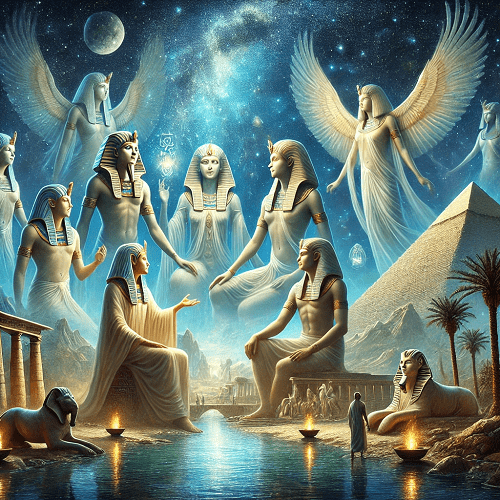
Egyptian Mythology
Egyptian mythology is one of the oldest and most complex in the world, rich in stories about gods, the creation of the universe and life after death. It is deeply intertwined with the religion and culture of Ancient Egypt, influencing every aspect of Egyptian life. The gods were seen as powerful forces that controlled nature and protected society.
Creation of the World:
In Egyptian mythology, various versions of the creation of the world exist, depending on the region and temple. One of the best-known myths comes from the city of Heliopolis, where the pantheon was led by the god Tuna. In the beginning, there was only the Nunthe primordial ocean of chaos.
From Nun, Atum emerged and created the first portion of land, called Benben. Atum, then, gave rise to the first gods by exhaling Shu (god of air) and spit Tefnut (goddess of humidity). From Shu and Tefnut were born Geb (god of the earth) and Nut (goddess of the sky).
Geb and Nut, in turn, had four children: Osiris, Isis, Set e Nephthyswho became central figures in Egyptian mythology. The rivalry between Osiris and Set, in particular, is one of the most important and influential stories, representing the struggle between order and chaos.
Important Gods and Deities:
- Tuna/Tea: Atum is the creator god who gave birth to the universe. He is often identified with Rathe sun god, who travels the sky by day and the underworld by night, fighting the serpent of chaos, Apep (Apophis). Ra is one of the most important deities in the Egyptian pantheon, and his cult was central to Egyptian religion.
- Osiris: God of the underworld and resurrection, Osiris is a central figure in Egyptian mythology. He is the ruler of the realm of the dead and is associated with the cycle of death and rebirth, both in the afterlife and in the fertility of the earth. Osiris was murdered by his brother Setbut was resurrected by his wife, Isisand became the ruler of the underworld.
- Isis: Goddess of magic, motherhood and protection, Isis is one of the most revered deities in Ancient Egypt. She is known for her role in reviving Osiris and for being the mother of Horusthe falcon god. Isis is often represented as a woman with a throne on her head or with cow horns, holding her son Horus.
- Sep: God of chaos, violence and the desert, Set is the brother of Osiris and the antagonist in many stories. He murdered Osiris to usurp the throne of Egypt, but was eventually defeated by Horus, the son of Osiris and Isis.
- Horus: Son of Osiris and Isis, Horus is the god of the sky, often represented as a falcon or a man with a falcon's head. He avenged his father's death by defeating Set, and is associated with Egyptian royalty. The pharaohs were considered to be incarnations of Horus.
- Anubis: God of mummification and protector of the dead, Anubis is represented as a man with the head of a jackal. He is responsible for guiding souls in the underworld and overseeing the mummification process. Anubis is also the guardian of the Duatthe Egyptian underworld.
- Thoth: God of wisdom, writing and magic, Thoth is often represented as a man with the head of an ibis or baboon. He is the scribe of the gods and the inventor of hieroglyphic writing, as well as being the mediator during the judgment of souls in the underworld.
- Hathor: Goddess of love, beauty, music and joy, Hathor is often represented as a cow or a woman with cow horns. She is one of the most benevolent deities and is associated with motherhood and protection.
The World of the Dead:
The Egyptian underworld, known as Duatis the kingdom ruled by Osiris, where the souls of the dead are judged. During the trial, the heart of the deceased is weighed in the Scales of Truth against the Maat (the goddess of truth and justice).
If the heart is lighter than the feather, the soul is considered pure and is admitted to the Juncos Fielda paradisiacal version of the afterlife. If it's heavier, the soul is devoured by AmmitThe creature is half crocodile, half lion and half hippopotamus.
The process of mummification was a vital part of Egyptian religion, as it was believed that the body needed to be preserved for the soul to survive in the afterlife. The tombs were decorated with texts and images that guided the soul through the dangers of the Duat, with amulets and offerings to ensure a safe passage.
Heroes and Legends:
- The Myth of Osiris: One of the most important myths in Egyptian mythology, it tells the story of how Osiris was murdered by his brother Set, who scattered his pieces throughout Egypt. Isis, with the help of her sister Nephthys and Anubis, collected the pieces of Osiris, temporarily resurrected him and conceived Horus. Horus later avenged his father by defeating Set, establishing order over chaos.
- The Sun and Ra: Ra's daily journey through heaven and the underworld is a metaphor for the eternal cycle of life, death and rebirth. During the night, Ra sails through the Duat in his boat, where he faces the serpent Apep, who tries to devour the sun. Ra's success in defeating Apep every night guarantees the return of the sun at dawn.
- The Benben Stone: The stone of Benben, on which Atum first appeared, is considered to be the place from which the first earth emerged. This sacred stone was often associated with Egyptian pyramids and temples, symbolizing creation and divine power.
Temples and worship:
The Egyptians built great temples dedicated to the gods, such as the temples of Karnak, Luxor and Abu Simbel. The pharaohs were seen as mediators between the gods and the people, performing rituals to maintain harmony between the human and divine worlds. The worship of the gods included offerings of food, incense and the recitation of hymns and prayers.
The Infinity of Mythologies Around the World
Although Greek, Nordic, Egyptian and Japanese mythologies, among others, are some of the best known and most widely studied, the truth is that the world is full of an almost infinite diversity of mythological traditions. Every culture, in every corner of the planet, has developed its own stories and beliefs to explain the origin of the universe, the nature of life and the complexity of existence.
From Australian Aboriginal mythology, with its stories about the Dream SeasonFrom the rich tapestry of myths of the indigenous cultures of the Americas to the complex belief systems of the peoples of Africa, Asia and Oceania, the variety of mythologies is simply astonishing.
Each of these mythologies offers a unique perspective on the world and the place of human beings in it, reflecting the values, hopes and challenges faced by these cultures over time.
It's practically impossible to list all mythologies in a single article, given the vast number of cultures and traditions that exist or have existed throughout human history. Each people has its own sacred stories, full of gods, heroes and supernatural beings, which form the basis of their beliefs and spiritual practices.
These mythologies, often passed down orally from generation to generation, not only explain the natural world and unexplained phenomena, but also establish the social and moral norms that guide community life. Even in cultures where mythologies are not so widely known, they play a vital role in preserving cultural identity and understanding the universe.
So while we can explore some of the best-known mythologies, it's important to remember that they are only a fraction of the rich global mythological tapestry. Each mythology, however small, offers a window into the depths of the human psyche and the diversity of ways in which different cultures understand and interact with the world around them.
The Role of Mythology in the Modern World
Mythological heritage continues to profoundly influence many areas of the modern world, including science, cultural traditions, religion, literature, theater, the visual arts, cinema, video games and much more.
For example, since ancient times, scientists have turned to mythology to name celestial bodies: all the planets (except Earth) and some of their satellites have been named after ancient Greek and Roman deities. Modern space missions and vehicles are also often named after mythical heroes, such as the American lunar missions Apollothe Chinese rover Zhurong and the lunar rover Chang'e.
Some mythological cultural and religious values still survive to this day. In Japan, the gods Kami continue to be revered, while in Russia, it is celebrated Maslenitsa, a festival whose roots go back to Slavic pagan times.
The study of the world's mythologies reveals that many modern stories are actually recreations or adaptations of ancient narratives. New material doesn't come out of nowhere; it's based on solid foundations that have been proven over thousands of years. Several popular franchises are directly inspired by myths, such as:
- Images from Slavic mythology served as the basis for the series of novels "The Witcher (16+), the movie "He's a Dragon"and the cartoons "Prince Vladimir" e "Three Heroes".
- The Norse myths became a rich source for the trilogy of books "The Lord of the Rings and the novel "The Silmarillionthe Marvel blockbusters "Thor", "Thor 2: The Dark World", e "Thor: Ragnarok"as well as popular anime series and video games.
- Plots from Greek myths and references to them are used in works such as the book "Atlas Shrugged, the cartoons "Hercules", "Icarus", e "Sinbad: Legend of the Seven Seas"in the movie series "Percy Jackson" and in video games Hades.
The science that studies myth systems is also known as mythology. By exploring ancient legends, it is possible to better understand the culture of ancient peoples, trace their relationships with other civilizations, reconstruct the migration of tribes across the continent and learn how traditions have blended over time.
I'm passionate about magic and spirituality, always looking for new knowledge about rituals, energies and the mystical universe. Here, I share magical practices and spiritual tips for those who want to connect more deeply with themselves and the world around them, all in a light and accessible way.
